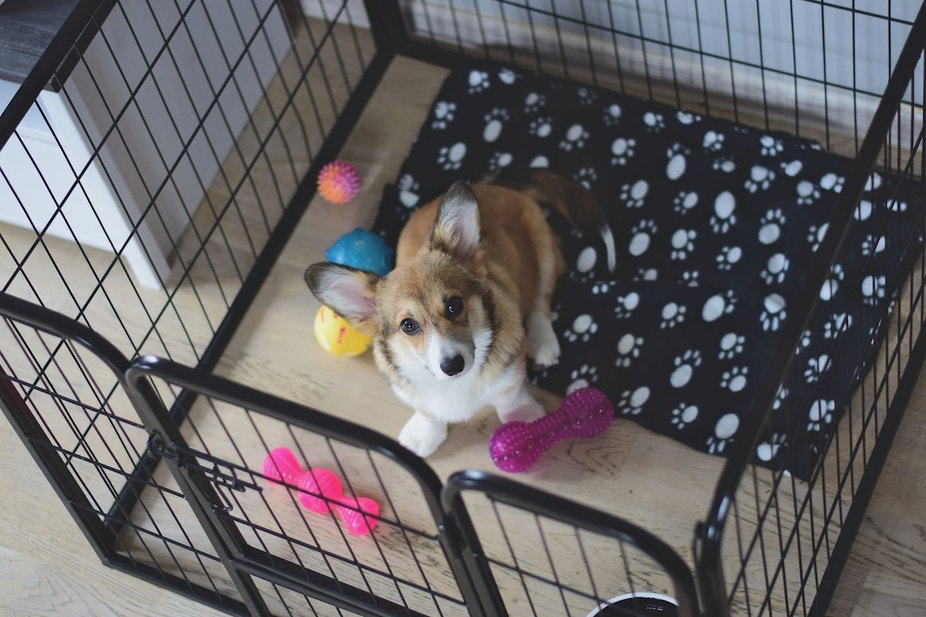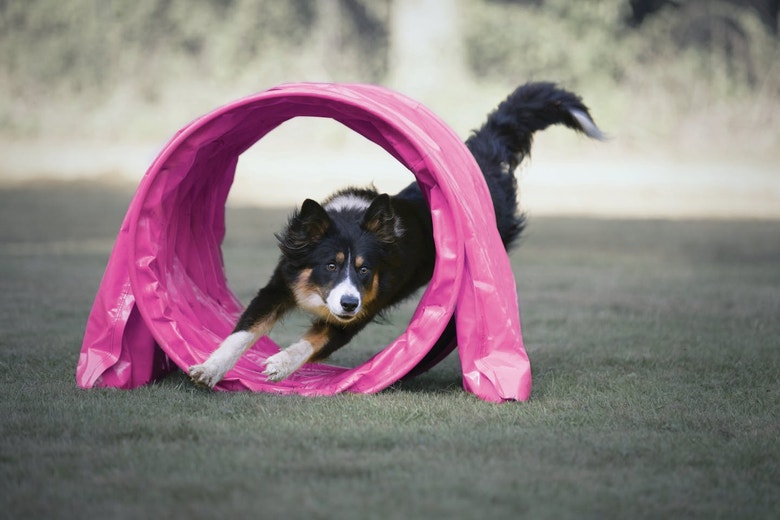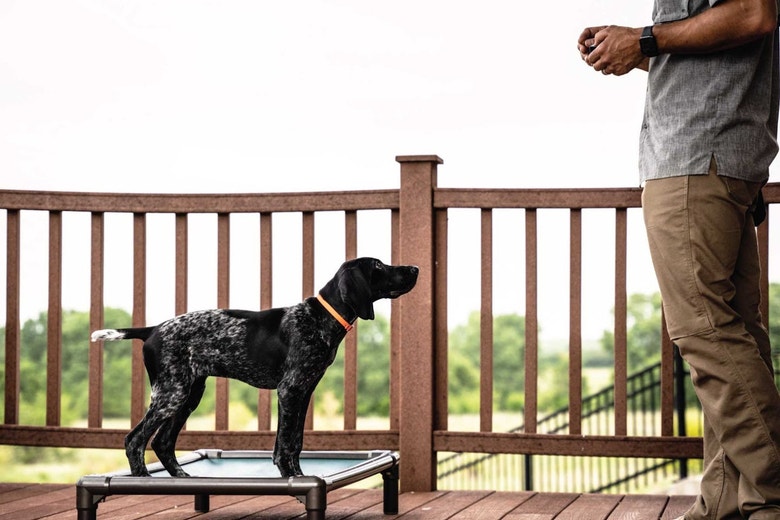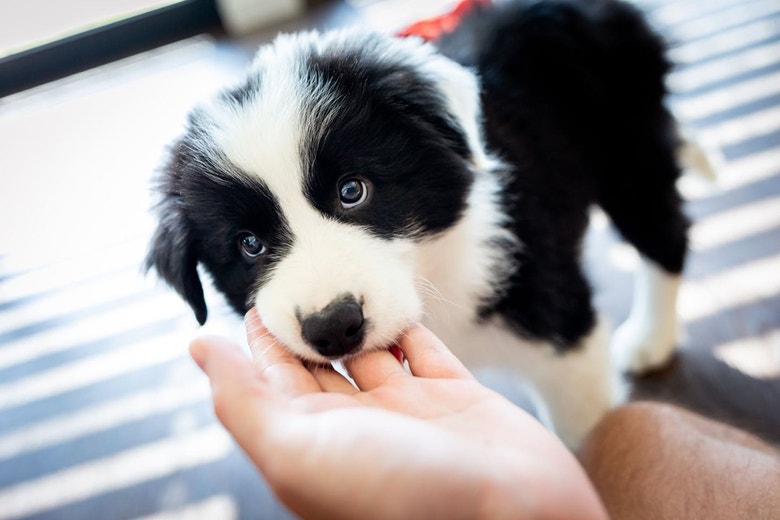
The Ultimate Guide To Crate Training Your Puppy
Crate training has proven to be an extremely effective tool for training a puppy. Many owners feel guilty about crate training their puppy, as placing them in a crate means confining them in a restricted place. However, when taught correctly, the crate can actually be seen as a safe haven for puppies - they have their own private den to retreat to whenever they are feeling overwhelmed.
In This Article
- What Are the Benefits of Crate Training A Puppy?
- When Should You Start Crate Training A Puppy?
- Can You Crate Train An Older Dog?
- How Do You Train An Older Dog To Sleep In A Crate?
- How Do I Crate Train My Puppy? A Step By Step Process
- How Long Should My Puppy Stay In the Crate?
- How To Crate Train Your Puppy At Night
- How To Choose The Right Crate For Your Puppy
- Common Problems When Starting Out Crate Training
- What Not To Do During Crate Training

WHAT ARE THE BENEFITS OF CRATE TRAINING?
Having a puppy crate eases many challenges of everyday life with a dog. The biggest motive for teaching a puppy to use a crate is that it’s proven to be an extremely handy tool when it comes to potty training a puppy and is the easiest form of transportation when your puppy needs to visit the vet, when you need to travel to a friend's house or when you’re going on a road trip.
Understanding the need for crate training is the first step, which is why we’ve created this detailed list on the benefits of crate training a puppy:
1. Crate Training Helps A Puppy With HOUSE TRAINING
The reasoning behind why a crate is so useful for house training is because puppies are very clean by nature, and they don’t like to be near their own urine-soaked space any more than you do. Selecting an appropriate crate size is essential for this as a crate that is too large may be seen by your puppy as an invitation to pee in one corner and sleep in another. Using a crate helps to teach your puppy to control their bladder and use signals to let you know that they need to go to potty.
When your puppy wants to go, they may proceed to whine and scratch at the crate. When your puppy demonstrates this kind of behavior, it's important that you act quickly and lead them to area they go potty outside.
2. Crate Training Can Help With Separation Anxiety:
Crate training can be beneficial for puppies who suffer from separation anxiety. Indeed, separation anxiety is becoming more common because pet owners were spending more time at home and are now returning to a more standard work schedule that their pets are not used to.
Creating a positive associating with the crate will encourage your puppy to want to use it and view the crate as a safe space to retreat to when needed. This positive association could be in the form of a food or verbal reward for entering the crate. In addition, initial sessions in the crate should be short and you should ensure that your puppy has had ample opportunity to eliminate before entering the crate. This will help avoid separation anxiety, which is easier to avoid than to untrain.
3. Crate Training Can Help To Prevent Bad Behaviour In Puppies:
A new puppy means that you need to be on watch constantly, which is not always realistic. One of the biggest perks of crate training is that it provides a space for your puppy to have some much-needed downtime while you attend to your day.
Leaving your puppy unsupervised can often be detrimental to your household. Puppies can become destructive when they’re left alone for too long without you around to entertain them. This is where a crate comes in handy: a couple of toys, some food and a comfy bed for them to rest while you’re gone and they’ll be much happier for it.
4. A Crate Provides A Safe Space For Your Puppy
Just like us, puppies need their space sometimes as well. Giving them an environment where they feel safe to retreat is essential for their overall happiness and mental health.
All we want to do when a new puppy (or any animal for that matter) is brought home is to round up our family and friends and introduce them. The introduction of a puppy to the family is a magical and exciting time, and it can be tempting to invite many friends and family to introduce them. While exposure is good for young puppies to learn socialization, it can also be stressful and overwhelming. That is why a crate can be beneficial, because it gives them a space to retreat to when they are feeling stressed. To that end, it is important not to physically remove your puppy from the crate when they have chosen to retreat there… Need them to come now? Get some treats and encourage them to come out on their own.
WHEN SHOULD YOU START CRATE TRAINING A PUPPY?
We recommend crate training your puppy from 8 weeks old - pretty much as soon as you bring them home. This gives your puppy plenty of time to familiarise themselves with their crate which will help them feel more relaxed and settled in your home.
We suggest having your crate set up before the puppy even breaches the front door so that you can introduce them to their crate straight away. Keep the crate open during the day so that they can go in and out of it as they please. It’s important that they’re not kept in their crate for long periods of time in the beginning, as this needs to be a gradual process.
CAN YOU CRATE TRAIN AN OLDER DOG?
There’s no reason why an older dog can’t be crate trained - it just may take a little longer to train them than it would a puppy. Here are a few benefits to crate training an older dog:
- Safety and preparedness in the case of an emergency
- Safe transportation when going on road trips or visiting the vet
- Provides safe confinement during illness
- Provides a safe place for your dog to relax during stressful or overwhelming situations
HOW DO YOU TRAIN AN OLDER DOG TO SLEEP IN A CRATE
The key to training an older dog to sleep in a crate is to have patience.
It often takes more time for an older dog to get used to its crate than it does a puppy. Everything is new and exciting for a puppy - there's no routine or habits for them to fall into. Older dogs however are creatures of habit, which is why the majority of their training will consist of helping them to unlearn old habits and introduce new ones.
HOW LONG SHOULD MY PUPPY STAY IN THE CRATE?
A puppy under the age of six months shouldn’t be left inside a crate for more than three to four hours at a time, as they have weak bladders with little to no control.
It’s important to err on the side of caution when crating, as crating a puppy for too long during the day can cause serious separation anxiety issues. It may also have an adverse effect if your puppy starts to hold on for too long during the day or develops a habit of going into the toilet inside the crate.
HOW TO CRATE TRAIN YOUR PUPPY AT NIGHT
Crate training your puppy at night follows pretty similar principles to regular crate training, however, it may be best to start by placing the crate in your bedroom or in a hallway nearby. Puppies often need to go outside to eliminate during the night, so you’ll want to place them somewhere you can hear them whining. Once your puppy is comfortable with falling asleep through the night beside you, you can start to gradually move their crate to your preferred location.

HOW DO I CRATE TRAIN MY PUPPY? STEP BY STEP PROCESS
Crate training a puppy takes time. How much time is dependent on a multitude of factors and shouldn’t really play a part in how you train your puppy. Instead, you need to ensure you’re consistent with their training and remain patient and positive throughout. Proceed with the crate training steps below and refrain from rushing your puppy through the process.
1) Introduce Your Puppy To Their Crate:
Introducing your puppy to their crate is made easier when you follow these simple steps. It’s important to place the crate in an area of your house that you’d like your puppy to spend most of their time in, such as the living room. Be sure to set up the crate to make it look as enticing as possible for your puppy. This includes a toy (or two), their food bowl and perhaps a few treats around the entrance to the crate and inside to encourage your puppy to enter. It’s important to remember not to force your puppy inside as they are likely to resist causing your training time to increase as well.
2) Feed Your Puppy Inside The Crate:
After introducing your puppy to the crate, begin feeding them regular meals near the crate. This will help to create a positive association. If your puppy is feeling more confident, start to slowly push their food bowl into the entrance of the crate, moving it further back each time until they’re comfortable eating their meals fully inside the crate.
Once your puppy has begun eating comfortably inside the crate you can close the door behind them until they’ve finished eating - opening it as soon as they’re finished eating. After every successful feeding, you can increase the amount of time they’re left in the crate, increasing their time spent in the crate.
3) How To Teach Your Puppy To Spend More Time in Their Crate :
When your puppy can eat their meals in the crate without showing any signs of anxiety or fear you can start to leave them inside the crate for longer periods.
The best way to encourage your puppy to spend time in their crate is by offering a reward. Start by calling your puppy over to the crate, once they’re close introduce a command such as “kennel” or “in”, and once inside, reward them with a treat and close the door behind them. Sit quietly near the entrance of the crate for 10 to 15 minutes before going into another room to get them used to being inside the crate on their own. Repeat this process a few times a day, making an effort to slowly increase the amount of time you’re out of sight when they’re inside the crate.
Once your puppy has learnt to sit inside the crate for longer than 30 minutes without whining you can begin to leave the house for short periods of time.

HOW TO CHOOSE THE RIGHT CRATE FOR YOUR PUPPY
There are many considerations to take into account when choosing the crate that best suits your puppy’s lifestyle. One of the first things to ask yourself is, where will you use the crate? Are you wanting to move the crate around a lot? Or are you hoping to use it as a tool for training your puppy? Either way, you’ll be glad to know that there are different crates to choose from depending on what activity you’re wanting to use it for.
METAL CRATES FOR PUPPIES
Metal crates provide a sturdy, safe place for your puppy to roam around in. Metal crates allow for plenty of ventilation for puppies with thick coats that feel the heat, as well as allow your puppy to see you the entire time which is useful for puppies with separation anxiety.
The downside to metal crates is that they’re heavy, which makes them difficult to move around.
PLASTIC CRATES FOR PUPPIES
Plastic puppy crates are more enclosed, offering more privacy and space for your puppy to spend on their own. Therefore, if you have a puppy that needs to escape when they’re feeling overwhelmed or simply need some downtime then a plastic crate could be the ideal choice.
Plastic crates are lightweight and easy to move, as well as clean. Another major benefit is that puppies find it harder to escape from plastic crates, whereas wire crates can sometimes allow your puppy to pull a houdini.
The only thing that you may need to be mindful of is that plastic crates don’t have as much ventilation as metal crates do.
SOFT-SIDED CRATES FOR PUPPIES
These types of crates aren’t for everyone. They’re more destructible than metal and plastic companions making it the wrong choice for puppies who like to scratch and chew at their confines.
For crate-trained or exceptionally calm puppies, a soft crate is a comfortable, lightweight travel option for puppies of any size.
COMMON PROBLEMS WHEN STARTING OUT CRATE TRAINING
If you thought training your puppy to use a crate was going to be an easy process without any problems along the way, you’re wrong.
Common problems that often arise when starting out in crate training are separation anxiety, whining and accidents in the crate. When it comes to crate training your puppy, the key to success is patience and plenty of positive reinforcement. With consistent training and well-planned strategies, you can teach a puppy to feel comfortable in their crate within one to three weeks of training.
WHAT NOT TO DO DURING CRATE TRAINING
- Don’t use the crate as a form of punishment: It’s important that your pup feels secure, safe and protected when inside their crate, essentially acting as a safe haven for them to escape to when needed. If you start to use their crate as a form of punishment it will be confusing for your puppy and most likely cause them to run away from the crate.
- Don’t leave your puppy in their crate for too long: Leaving a puppy in a crate for too long can cause issues with separation anxiety and accidents in the crate. As we mentioned before, it’s best to start out slow and increase their time inside the create over longer periods of time.
- Don’t let your puppy out of the crate because they’re whining: Whining is tricky. It’s hard to know if a puppy is whining because they need to go to the toilet or simply because they want to be let out of the crate and have learnt that whining is a way to accomplish this.
- Don’t force your puppy inside the crate: Forcing your puppy inside the crate before they’re ready can have an adverse effect. They will most likely grow to fear the crate and run away from it rather than treat it as a safe space for them to relax in.
There will be ups and downs during your puppy’s crate training, but success will come - in time. It’s important to remain patient during this entire process. Getting angry, frustrated or aggressive with your dog likely reverse your training efforts and even cause them to mistrust you. As long as you remain calm and consistent in your training, your puppy will eventually reward you by learning to successfully use their crate.




